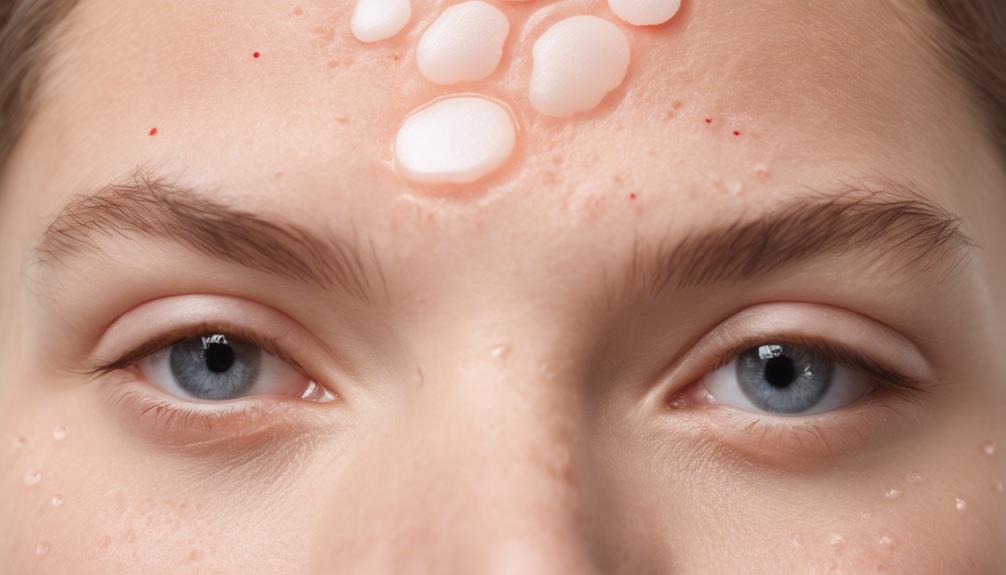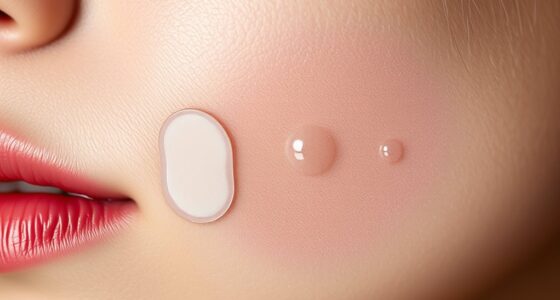Acne patches can help prevent scarring by reducing inflammation and minimizing skin picking, which often worsens scars. They gently lift impurities and pus, helping you avoid manual squeezing that damages skin. Choosing the right patch and applying it correctly also lessen irritation and post-inflammatory marks. While they aren’t a complete cure, using patches properly can support scar prevention. If you keep exploring, you’ll discover how to maximize their benefits for your skin.
Key Takeaways
- Acne patches absorb excess oil and reduce inflammation, helping prevent skin picking that can cause scars.
- They facilitate gentle extraction of impurities, minimizing skin trauma compared to manual squeezing.
- Proper patch selection and application minimize skin irritation, reducing the risk of post-inflammatory hyperpigmentation and scars.
- Using patches on broken or inflamed skin may worsen damage, potentially leading to scars.
- Overall, acne patches can help prevent scarring when used correctly as part of a gentle skincare routine.

Acne patches have become a popular and effective solution for treating breakouts quickly, but many people wonder if they can also help with scars. While these patches are primarily designed to absorb excess oil and reduce inflammation, some believe they might prevent scarring if used correctly. However, it’s important to understand their role in pimple extraction and the potential for skin irritation. When you apply an acne patch, you’re fundamentally creating a barrier over the blemish, which can help keep you from picking at your skin. Picking or squeezing pimples often leads to skin irritation and increases the risk of scars forming, so in that sense, patches can indirectly help prevent scars by discouraging harmful habits.
That said, the actual process of pimple extraction with patches is gentle because they work by lifting impurities and pus from within the pore. They don’t require you to manually squeeze or poke, which reduces the chances of damaging your skin further. This gentle extraction can be beneficial in preventing scars, especially if it helps you avoid more aggressive methods like squeezing or digging into your blemishes. However, it’s vital to choose the right type of patch—those with hydrocolloid or similar ingredients—since they’re designed to absorb fluids without causing additional skin irritation. If you use the wrong patches or leave them on too long, you might irritate your skin, leading to redness or even post-inflammatory hyperpigmentation, which can look like scars.
Skin irritation is a common concern when using acne patches, especially if you have sensitive skin. If a patch doesn’t adhere well or causes discomfort, you might be tempted to remove it prematurely or scratch at your skin, both of which can create scars or worsen existing ones. To minimize this risk, make sure your skin is clean and dry before applying a patch. Avoid using patches on broken or irritated skin, as this can exacerbate the problem. If you notice increased redness, swelling, or discomfort, it’s better to remove the patch and give your skin time to recover. Additionally, understanding the importance of professional skincare advice can help you make better choices about managing acne and preventing scars.
Frequently Asked Questions
Do All Acne Patches Contain Ingredients That Prevent Scarring?
Not all acne patches contain ingredients that prevent scarring. You should check the ingredient efficacy of each patch, as some include soothing agents like salicylic acid or tea tree oil, which may help reduce inflammation. Patch durability varies, so choose ones that stay put and protect your skin effectively. Remember, while some patches offer benefits, others might lack active ingredients for scarring prevention, so read labels carefully.
How Quickly Can Acne Patches Reduce the Risk of Scarring?
You might wonder how quickly acne patches can reduce scarring risk. While hydrocolloid effectiveness varies, many patches start working within hours by absorbing excess fluid and reducing inflammation. However, ingredient variability impacts how well they promote healing and prevent scars. Consistent use, especially on early blemishes, can help minimize scarring over days to weeks, but no patch guarantees instant results. Patience and proper treatment are key to effective scar prevention.
Are There Specific Types of Acne Patches More Effective for Scarring?
You might find that certain acne patches are more effective for scarring because of ingredient efficacy. Patches with ingredients like hydrocolloids help reduce inflammation and promote healing, which can minimize scars. Additionally, patch durability guarantees they stay in place longer, giving ingredients more time to work. Look for patches designed with these features to enhance your scar prevention efforts, as they’re more likely to deliver targeted, effective care.
Can Acne Patches Be Used Alongside Other Scar Prevention Treatments?
You can definitely combine treatments to prevent scars effectively. Using acne patches alongside other scar prevention methods, like topical retinoids or silicone gels, helps target multiple aspects of healing. Combining treatments enhances your chances of preventing scars by reducing inflammation and promoting tissue repair. Just make sure to consult with a dermatologist to create a personalized plan that safely integrates acne patches with other scar prevention strategies for the best results.
Do Acne Patches Work Better on Certain Skin Types to Prevent Scars?
You wonder if acne patches work better on certain skin types to prevent scars. Generally, skin type influences how well ingredients in patches absorb and perform. For example, oily skin might benefit more from patches with ingredients like salicylic acid, which cut through oil, while sensitive skin may need gentler options like hydrocolloid. Understanding your skin type helps you choose patches with the most effective ingredients for scar prevention.
Conclusion
While acne patches can help reduce the risk of scarring by preventing picking and protecting your skin, they aren’t magic. Think of them as tiny guardians, standing between you and lasting scars. Remember, your skin’s healing journey is part of your story—embrace patience and care. With consistent use and gentle handling, you can turn the page toward clearer, healthier skin. Your future self will thank you for the love and attention you give today.










